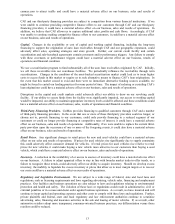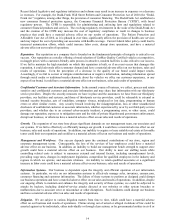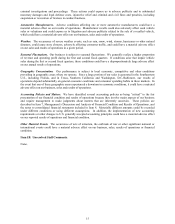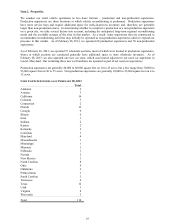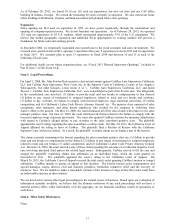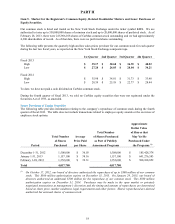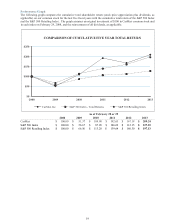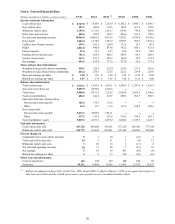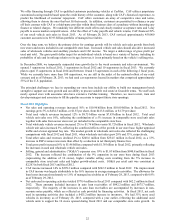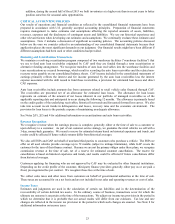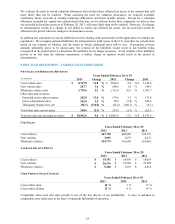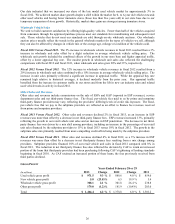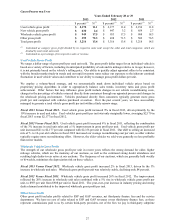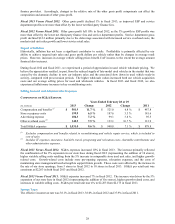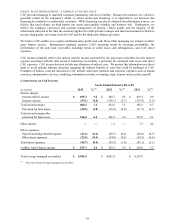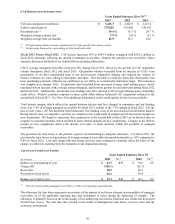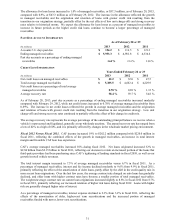CarMax 2013 Annual Report Download - page 27
Download and view the complete annual report
Please find page 27 of the 2013 CarMax annual report below. You can navigate through the pages in the report by either clicking on the pages listed below, or by using the keyword search tool below to find specific information within the annual report.addition, during the second half of fiscal 2013 we built inventories at a higher rate than in recent years to better
position ourselves for seasonal sales opportunities.
CRITICAL ACCOUNTING POLICIES
Our results of operations and financial condition as reflected in the consolidated financial statements have been
prepared in accordance with U.S. generally accepted accounting principles. Preparation of financial statements
requires management to make estimates and assumptions affecting the reported amounts of assets, liabilities,
revenues, expenses and the disclosures of contingent assets and liabilities. We use our historical experience and
other relevant factors when developing our estimates and assumptions. We continually evaluate these estimates and
assumptions. Note 2 includes a discussion of significant accounting policies. The accounting policies discussed
below are the ones we consider critical to an understanding of our consolidated financial statements because their
application places the most significant demands on our judgment. Our financial results might have been different if
different assumptions had been used or other conditions had prevailed.
Financing and Securitization Transactions
We maintain a revolving securitization program composed of two warehouse facilities (“warehouse facilities”) that
we use to fund auto loan receivables originated by CAF until they are funded through a term securitization or
alternative funding arrangement. We recognize transfers of auto loan receivables into the warehouse facilities and
term securitizations as secured borrowings, which result in recording the auto loan receivables and the related non-
recourse notes payable on our consolidated balance sheets. CAF income included in the consolidated statements of
earnings primarily reflects the interest and fee income generated by the auto loan receivables less the interest
expense associated with the debt issued to fund these receivables, a provision for estimated loan losses and direct
CAF expenses.
Auto loan receivables include amounts due from customers related to retail vehicle sales financed through CAF.
The receivables are presented net of an allowance for estimated loan losses. The allowance for loan losses
represents an estimate of the amount of net losses inherent in our portfolio of managed receivables as of the
applicable reporting date and anticipated to occur during the following 12 months. The allowance is primarily based
on the credit quality of the underlying receivables, historical loss trends and forecasted forward loss curves. We also
take into account recent trends in delinquencies and losses, recovery rates and the economic environment. The
provision for loan losses is the periodic expense of maintaining an adequate allowance.
See Notes 2(F), 2(I) and 4 for additional information on securitizations and auto loan receivables.
Revenue Recognition
We recognize revenue when the earnings process is complete, generally either at the time of sale to a customer or
upon delivery to a customer. As part of our customer service strategy, we guarantee the retail vehicles we sell with a
5-day, money-back guarantee. We record a reserve for estimated returns based on historical experience and trends, and
results could be affected if future vehicle returns differ from historical averages.
We also sell ESPs and GAP on behalf of unrelated third parties to customers who purchase a vehicle. The ESPs we
offer on all used vehicles provide coverage up to 72 months (subject to mileage limitations), while GAP covers the
customer for the term of their finance contract. Because we are not the primary obligor under these plans, we recognize
commission revenue at the time of sale, net of a reserve for estimated customer cancellations. The reserve for
cancellations is based on historical experience and trends, and results could be affected if future cancellations differ
from historical averages.
Customers applying for financing who are not approved by CAF may be evaluated by other financial institutions.
Depending on the credit profile of the customer, third-party finance providers generally either pay us or are paid a
fixed, pre-negotiated fee per contract. We recognize these fees at the time of sale.
We collect sales taxes and other taxes from customers on behalf of governmental authorities at the time of sale.
These taxes are accounted for on a net basis and are not included in net sales and operating revenues or cost of sales.
Income Taxes
Estimates and judgments are used in the calculation of certain tax liabilities and in the determination of the
recoverability of certain deferred tax assets. In the ordinary course of business, transactions occur for which the
ultimate tax outcome is uncertain at the time of the transactions. We adjust our income tax provision in the period in
which we determine that it is probable that our actual results will differ from our estimates. Tax law and rate
changes are reflected in the income tax provision in the period in which such changes are enacted. See Note 8 for
additional information on income taxes.
23


